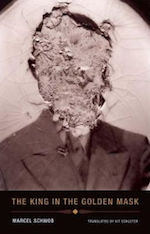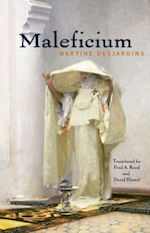Using a historical setting for a tale of monsters or terror can be a reliable way to increase suspense and provide a counterpoint for the horrors described therein. Whether it’s Edgar Allan Poe summoning up a bygone age—and its accompanying menaces—in “The Masque of the Red Death” or, more recently, John Ostrander and Tom Mandrake setting their graphic novel Kros: Hallowed Ground against the backdrop of the Battle of Gettysburg, it’s the kind of narrative decision that can accentuate certain themes and ratchet up the tension even further.
But a specific point in history can also summon up a number of more mundane terrors over the course of a narrative: totalitarian governments, horrific attitudes about race and gender, and unrestrained abuses coming from the powerful all come to mind. Sometimes reading a story set in the past can haunt us for reasons other than literal monsters that lurk on the page. What follows is a look at five books that explore the demons of the past along with monsters in the past…
Blood Crime, Sebastià Alzamora (translated by Maruxa Relaño and Martha Tennent)
 The Spanish Civil War has, in the last decade and a half, been the setting for a number of notable works of horror and the supernatural, with Guillermo del Toro’s film Pan’s Labyrinth being the highest-profile example. The novel Blood Crime features plenty of horrible behavior on the part of its human characters, who are caught between warring factions, along with mounting evidence that the killer stalking the city of Barcelona is either a vampire or someone who believes himself to be one. Narration from a jaded and undead voice punctuates the novel, suggesting that the former is the case. And the book gets weirder and weirder as it approaches its climax, including a subplot that riffs on a very different work of Gothic fiction.
The Spanish Civil War has, in the last decade and a half, been the setting for a number of notable works of horror and the supernatural, with Guillermo del Toro’s film Pan’s Labyrinth being the highest-profile example. The novel Blood Crime features plenty of horrible behavior on the part of its human characters, who are caught between warring factions, along with mounting evidence that the killer stalking the city of Barcelona is either a vampire or someone who believes himself to be one. Narration from a jaded and undead voice punctuates the novel, suggesting that the former is the case. And the book gets weirder and weirder as it approaches its climax, including a subplot that riffs on a very different work of Gothic fiction.
The King in the Golden Mask, Marcel Schwob (translated by Kit Schluter)
 The stories in this 1892 collection, newly translated into English in its entirety, abound with glimpses of European history where horrific violence occurs, terrifying secrets are revealed, and conflicted characters descend into madness. Translator Kit Schluter, in his afterword, notes that the book “suggests time and time again that one’s true identity comes to light only in the crucible of a struggle so intense that it bares him of any privilege or nicety behind which he could otherwise hide.” Schwob’s vision encapsulates royalty and everyday people alike, and shows all of them capable of monstrous acts and harrowing moments of self-deception. For Schwob, the past is more charnel house than museum piece.
The stories in this 1892 collection, newly translated into English in its entirety, abound with glimpses of European history where horrific violence occurs, terrifying secrets are revealed, and conflicted characters descend into madness. Translator Kit Schluter, in his afterword, notes that the book “suggests time and time again that one’s true identity comes to light only in the crucible of a struggle so intense that it bares him of any privilege or nicety behind which he could otherwise hide.” Schwob’s vision encapsulates royalty and everyday people alike, and shows all of them capable of monstrous acts and harrowing moments of self-deception. For Schwob, the past is more charnel house than museum piece.
The Fisherman, John Langan
 Much of John Langan’s award-winning novel The Fisherman unfolds in the recent past, as its narrator describes a fishing trip in New York’s Hudson River Valley that takes a turn for the cosmically horrific. But nestled in there is another tale of horror, set across two centuries and involving a war profiteer, the resurrection of the dead, and a trip to the shores of an otherworldly ocean. It’s a powerful counterpoint to the framing story, one which establishes a cyclical nature to the novel’s central menace and shows how different moments in time react to similar supernatural conspiracies.
Much of John Langan’s award-winning novel The Fisherman unfolds in the recent past, as its narrator describes a fishing trip in New York’s Hudson River Valley that takes a turn for the cosmically horrific. But nestled in there is another tale of horror, set across two centuries and involving a war profiteer, the resurrection of the dead, and a trip to the shores of an otherworldly ocean. It’s a powerful counterpoint to the framing story, one which establishes a cyclical nature to the novel’s central menace and shows how different moments in time react to similar supernatural conspiracies.
The Essex Serpent, Sarah Perry
 Trying to categorize Sarah Perry’s sprawling novel, set in London and Essex in the late 19th century, isn’t an easy thing. It’s about the star-crossed connection between the newly-widowed Cora Seaborne and the Reverend William Ransome, each sympathetic and flawed. But there’s also the possibility of a sea serpent lurking just off the coast; there’s a mysterious epidemic of madness going around, and there are a host of nerve-wracking scenes of anatomies dissected and pondered. Some of this comes from the novel’s third major character, Dr. Luke Garrett, a man of science decades ahead of his time–which, in another novel, might mark him as the sort of character who meddles in nature and unleashes monsters. But that isn’t this kind of story–and Perry’s manipulation of expectations makes for a breath of fresh air even as she summons dread with other aspects of the novel.
Trying to categorize Sarah Perry’s sprawling novel, set in London and Essex in the late 19th century, isn’t an easy thing. It’s about the star-crossed connection between the newly-widowed Cora Seaborne and the Reverend William Ransome, each sympathetic and flawed. But there’s also the possibility of a sea serpent lurking just off the coast; there’s a mysterious epidemic of madness going around, and there are a host of nerve-wracking scenes of anatomies dissected and pondered. Some of this comes from the novel’s third major character, Dr. Luke Garrett, a man of science decades ahead of his time–which, in another novel, might mark him as the sort of character who meddles in nature and unleashes monsters. But that isn’t this kind of story–and Perry’s manipulation of expectations makes for a breath of fresh air even as she summons dread with other aspects of the novel.
Maleficium, Martine Desjardins (translated by Fred A. Reed and David Homel)
 The framing story of Martine Desjardins’s Maleficium is fascinating: it’s ostensibly a found document from the Archdiocese of Montreal, documenting a series of 19th-century confessions too horrific or bizarre for public consumption. Each of the chapters is a standalone vignette, with ominous titles in Latin like “Oculus Malignus” and “Osculum Infame.” There’s body horror aplenty here, as well–one of the narratives, about a parasitic insect, features an abundance of literally gut-wrenching prose. Over the course of the book, certain themes come into focus as well: colonialist abuses coming back to hurt their perpetrators, with acts of sexist violence and negligence turned on their head with vicious consequences.
The framing story of Martine Desjardins’s Maleficium is fascinating: it’s ostensibly a found document from the Archdiocese of Montreal, documenting a series of 19th-century confessions too horrific or bizarre for public consumption. Each of the chapters is a standalone vignette, with ominous titles in Latin like “Oculus Malignus” and “Osculum Infame.” There’s body horror aplenty here, as well–one of the narratives, about a parasitic insect, features an abundance of literally gut-wrenching prose. Over the course of the book, certain themes come into focus as well: colonialist abuses coming back to hurt their perpetrators, with acts of sexist violence and negligence turned on their head with vicious consequences.
Top image: Pan’s Labyrinth (2006).
 Tobias Carroll is the managing editor of Vol.1 Brooklyn. He is the author of the short story collection Transitory (Civil Coping Mechanisms) and the novel Reel (Rare Bird Books).
Tobias Carroll is the managing editor of Vol.1 Brooklyn. He is the author of the short story collection Transitory (Civil Coping Mechanisms) and the novel Reel (Rare Bird Books).










